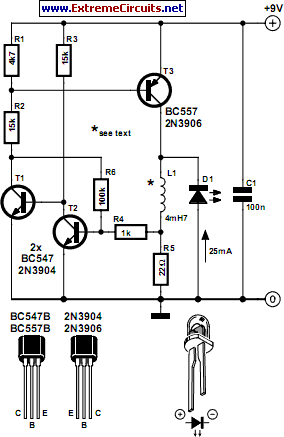Home » Circuits
Thrifty LED Protector
An LED is sure to fail if the current through it is too high. You will soon discover this after you have blown a few up. A simple resistor in series suffices to solve the problem and a better solution is almost inconceivable, because in this case you need only one additional cheap component. As the power supply voltage increases, an increasing amount of power is lost in the resistor. In particular with battery-powered equipment it is worthwhile to make a power-saving version, which does require a few more parts however.The circuit shown in the figure has deliberately been designed with parts that everyone will have lying around, except perhaps the small coil. In nearly all modern switching power supplies there is an attempt to monitor the current. It is generally the case that components will fail if the current or power is too high and this is very effectively avoided with this technique. It works like this. Resistor R5 measures the current through the coil and T2 ‘watches’ to make sure it doesn’t become too large.
L1 will never go into saturation, which could cause T3 to give up the ghost. As soon as the current through R5 increases to about 25 mA, T2 will conduct, T1 will block and T3 will also block. The current cannot flow through T3 any more and will look for another path, in this case through LED D1, which will now light up. By placing D1 in this position it acts in fact as a free-wheeling diode, which is good for the efficiency. As soon as the current drops, T2 will block again and T3 will conduct.
Circuit diagram:
R6 provides a small amount of hysteresis so that the switching frequency of about 50 kHz does not become unnecessarily high (which would increase the loss). The circuit works from about five volts, depending on the forward voltage of the LED. From about 9V you will clearly notice the improvement in efficiency. The circuit is suitable for all types of LEDs, including the blue and white ones that need 3.5 V. The voltage that is generated by the coil will automatically adapt. The maximum power supply voltage is 24 V.
A little clarification regarding the choice of coil: the value is not critical, it could just as easily be 3.9 mH or 6.8 mH. Even 10 mH can be used, especially if the power supply voltage is greater than 9 V. The coil does need to be suitable for at least 25 mA. You can usually take a guess based on the physical dimensions of the coil. The coil will have to be at least 15 mm long and have a diameter of 7 mm. Incidentally, there have been great advances regarding coils in the least few years. Modern SMD-coils are much smaller and can nevertheless handle high currents. Unfortunately they are not usually available in values over 1 mH.
Copyright: Elektor Electronics

